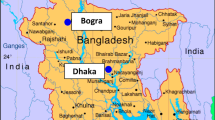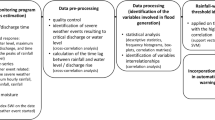Abstract
Both fluvial and pluvial floods are a common occurrence in Fiji with fluvial floods causing significant economic consequences for island nations. To investigate flood risk and provide a mitigation tool on daily basis, the Flood Index (\(I_{F}\)) is developed based on the rationale that the onset and severity of an event is based on current and antecedent day’s precipitation. This mathematical methodology considers the notion that the impact of daily cumulative precipitation on a particular flood event arising from a previous day’s precipitation, decreasing gradually over time due to the interaction of hydrological factors (e.g., evaporation, percolation, seepage, surface run-off, drainage, etc.,). These are accounted for, mathematically, by a time-reduction weighted precipitation influencing the magnitude of \(I_{F }\). Considering the duration, severity and intensity of all identified events, the applicability of \(I_{F}\) is tested at 9 study sites in Fiji using 30-year precipitation datasets (1990–2019) obtained from Fiji Meteorological Services. Newly developed \(I_{F}\) is adopted at flood prone sites, with results demonstrating that flood events were common throughout the country, mostly notable between November to April (or the wet season). Upon examining the variations in daily \(I_{F}\), the flood properties were determined, showing that the most severe events generally started in January. Flood events with the highest severity were recorded in Lautoka [\(I_{F}^{acc}\) (flood severity) \(\approx 149.14\), \(I_{F}^{max}\) (peak danger) \(\approx 3.39\), \(D_{F}\) (duration of flood) \(\approx 151\;{\text{days}}\), \(t_{onset}\) (onset date) \(= 23{\text{rd}}\;{\text{January}}\;2012\)], followed by Savusavu \((I_{F}^{acc} \approx 141.65, I_{F}^{max} \approx 1.75, D_{F} \approx 195\; {\text{days}}, t_{onset} = 27{\text{th}}\;{\text{November}}\;1999)\) and Ba \((I_{F}^{acc} \approx 131.57, I_{F}^{max} \approx 3.13, D_{F} \approx 113 \;{\text{days}}, t_{onset} = 9{\text{th}}\;{\text{January}}\;2009)\). The results clearly illustrate the practicality of daily \(I_{F}\) in determining the duration, severity, and intensity of flood situation, as well as its potential application to small island nations. The use of daily \(I_{F}\) to quantify flood events can therefore enable a cost-effective and innovative solution to study historical floods in both developing and first world countries. Our methodology is particularly useful to governments, private organizations, non-governmental organizations and communities to help develop community-amicable policy and strategic plans to prepare for flood impacts and undertake the necessary risk mitigation measures.













Similar content being viewed by others
Abbreviations
- \(D_{F}\) :
-
Duration of flood
- \(I_{F}\) :
-
Flood Index
- \(I_{F}^{acc}\) :
-
Flood severity
- \(I_{F}^{max}\) :
-
Peak danger
- P :
-
Precipitation
- \(P_{E}\) :
-
Effective Precipitation
- AWRI:
-
Available Water Resource Index
- FJD:
-
Fijian Dollar
- GDP:
-
Gross Domestic Product
- SPCZ:
-
South Pacific Convergence Zone
- SPI:
-
Standardized Precipitation Index
- SWAP:
-
Standardized Weighted Average of Precipitation
- WAP:
-
Weighted Average of Precipitation
References
Brown P, Daigneault A, Gawith D (2016) Climate change and the economic impacts of flooding on Fiji. Clim Dev 9:493–504
Byun H-R, Chung J-S (1998) Quantified diagnosis of flood possibility by using Effective Precipitation Index. J Korea Water Resour Assoc 31:657–665
Byun H-R, Lee D-K (2002) Defining three rainy seasons and the hydrological summer monsoon in Korea using available water resources index. J Meteorol Soc Jpn Ser II 80:33–44
Campbell JR (1984) Dealing with disaster: hurricane response in Fiji. Honolulu: Pacific Islands Development Program, East-West Center; Suva: Govt…
Deo R, Byun H, Adamowski J, Kim D (2014) Diagnosis of flood events in Brisbane (Australia) using a flood index based on daily effective precipitation. In: International conference: analysis and management of changing risks for natural hazards, pp AP20-1. European Commission, 7th framework programme, Marie Curie Actions…
Deo RC, Byun H-R, Adamowski JF, Kim D-W (2015) A real-time flood monitoring index based on daily effective precipitation and its application to Brisbane and Lockyer Valley flood events. Water Resour Manag 29:4075–4093
Deo RC, Adamowski JF, Begum K, Salcedo-Sanz S, Kim D-W, Dayal KS, Byun H-R (2018a) Quantifying flood events in Bangladesh with a daily-step flood monitoring index based on the concept of daily effective precipitation. Theor Appl Climatol 137:1201–1215
Deo RC, Byun H-R, Kim G-B, Adamowski JF (2018b) A real-time hourly water index for flood risk monitoring: pilot studies in Brisbane, Australia, and Dobong Observatory, South Korea. Environ Monit Assess 190:450
Feresi J, Kenny GJ, de Wet N, Limalevu L, Bhusan J, Ratukalou I (2000) Climate change vulnerability and adaptation assessment for Fiji. The International Global Change Institute (IGCI), University of Waikato, Hamilton
Fiji Meteorological Service (2018) A weak El Niño likely to develop in the later part of 2018, vol 11, issue 6, 28 November. https://www.met.gov.fj/ENSO_Update.pdf
Guerreiro MJ, Lajinha T, Abreu I (2008) Flood analysis with the Standardized Precipitation Index (SPI). Retreived Online: https://www.researchgate.net/publication/239919916_Flood_analysis_with_the_standardized_precipitation_index_SPI
Han SU, Byun HR (2006) The existence and the climatological characteristics of the spring rainy period in Korea. Int J Climatol J R Meteorol Soc 26:637–654
Keoduangsine S, Robert R, Gardner-Stephen P (2014) A review of flood warning systems in developed and developing countries. Int J Future Comput Commun 3:172–176
Lal PN (2009) Economic costs of the 2009 floods in the Fiji sugar belt and policy implications. IUCN, Washington, DC
Lu E (2009) Determining the start, duration, and strength of flood and drought with daily precipitation: rationale. Geophys Res Lett 36:1–5
Lu E, Cai W, Jiang Z, Zhang Q, Zhang C, Higgins RW, Halpert MS (2013) The day-to-day monitoring of the 2011 severe drought in China. Clim Dyn 43:1–9
Ma T, Li C, Lu Z, Wang B (2014) An effective antecedent precipitation model derived from the power-law relationship between landslide occurrence and rainfall level. Geomorphology 216:187–192
MathWorks (2019) MATLAB. Retreived Online: https://au.mathworks.com/products/new_products/release2019a.html
McKee TB, Doesken NJ, Kleist J (1993) The relationship of drought frequency and duration to time scales. In: Proceedings of the 8th conference on applied climatology, vol 17. American Meteorological Society, Boston, pp 179–183
Nawai J, Gusyev M, Hasegawa A, Takeuchi K (2015) Flood and drought assessment with dam infrastructure: a case study of the Ba River basin, Fiji. In: Weber T, McPhee MJ, Anderssen RS (eds) MODSIM2015, 21st International Congress on modelling and simulation. Modelling and Simulation Society of Australia and New Zealand, pp 1607–1613
Nosrati K, Saravi MM, Shahbazi A (2010) Investigation of flood event possibility over Iran using Flood Index. In: Survival and sustainability. Springer, Berlin, pp 1355–1361
Office of the Prime Minister (2009) Consolidated report on flash floods—8th–16th January 2009—damages sustained and necessary responses, rehabilitation and reconstruction
Seiler RA, Hayes M, Bressan L (2002) Using the standardized precipitation index for flood risk monitoring. Int J Climatol 22:1365–1376
The World Bank Group (2019) The World Bank data, vol 2020. The World Bank Group, Washington, DC
Wallemacq P, House R (2018) Economic losses, poverty and disasters 1998–2017. Centre for Research on the Epidemiology of Disasters, Brussels
Wang Z-L, Cao L (2011) Analysis on characteristics of droughts and floods of Zhengzhou City based on SPI in recent 60 years. J North China Inst Water Conserv Hydroelectr Power 6. Retreived Online: https://en.cnki.com.cn/Article_en/CJFDTotal-HBSL201106008.htm
Yeo S (2013) A review of flood resilience in Fiji. In: International conference on flood resilience, “Experiences in Asia and Europe,” University of Exeter, UK, September”, pp 5–7
Yeo SW, Blong RJ (2010) Fiji’s worst natural disaster: the 1931 hurricane and flood. Disasters 34:657–683
Yevjevich VM (1967) Objective approach to definitions and investigations of continental hydrologic droughts, An. Hydrology papers (Colorado State University); No. 23
Yevjevich V (1991) Tendencies in hydrology research and its applications for 21st century. Water Resour Manag 5:1–23
Acknowledgements
The first author, Mohammed, M., is an Australia Awards Scholar supported by Australian Government. He is grateful to Australian Department of Foreign Affairs and Trade for funding this study through the Australia Awards Scholarship scheme 2020-2021. Disclaimer: The views and opinions expressed in this paper are those of the authors and do not represent the views of the Australian Government. The authors thank Fiji Meteorological Service for providing the rainfall data required for this project.
Author information
Authors and Affiliations
Corresponding author
Additional information
Publisher's Note
Springer Nature remains neutral with regard to jurisdictional claims in published maps and institutional affiliations.
Rights and permissions
About this article
Cite this article
Moishin, M., Deo, R.C., Prasad, R. et al. Development of Flood Monitoring Index for daily flood risk evaluation: case studies in Fiji. Stoch Environ Res Risk Assess 35, 1387–1402 (2021). https://doi.org/10.1007/s00477-020-01899-6
Accepted:
Published:
Issue Date:
DOI: https://doi.org/10.1007/s00477-020-01899-6




